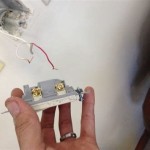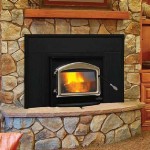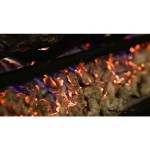Refacing A Fireplace With Stone: A Comprehensive Guide
A fireplace serves as a focal point in many homes, providing warmth and aesthetic appeal. Over time, the existing facade of a fireplace may become outdated, damaged, or simply no longer align with the homeowner's design preferences. Refacing a fireplace with stone offers a transformative solution, allowing for a significant aesthetic upgrade without the extensive demolition and reconstruction associated with a full fireplace replacement. This article provides a detailed overview of the process, considerations, and advantages of refacing a fireplace with stone.
Refacing a fireplace involves covering the existing surface with a new material. In the case of stone refacing, natural or manufactured stone veneers are applied to the existing fireplace surround. This technique retains the original structure of the fireplace while dramatically altering its appearance. Successful stone refacing requires careful planning, material selection, and skillful execution.
Before embarking on a stone refacing project, a thorough assessment of the existing fireplace is crucial. This assessment involves evaluating the structural integrity of the existing facade, identifying any areas of damage, and determining the type of material currently in place. Understanding the existing conditions will inform the subsequent steps and ensure a durable and aesthetically pleasing result.
Assessing the Existing Fireplace Structure
The structural integrity of the existing fireplace is paramount. Any signs of cracking, crumbling, or instability must be addressed before applying stone veneer. If the existing facade is significantly damaged, repairs may be necessary to provide a stable foundation for the new stone. This could involve patching cracks with mortar, replacing damaged bricks, or reinforcing the underlying structure.
The type of material currently covering the fireplace will influence the preparation required. For example, a painted brick fireplace may require thorough cleaning and the application of a bonding agent to ensure proper adhesion of the stone veneer. A smooth, non-porous surface like tile may need to be roughened to create a mechanical bond. Proper surface preparation is essential for preventing the stone veneer from detaching over time.
The dimensions of the existing fireplace must be accurately measured. These measurements will determine the amount of stone veneer needed and will guide the layout and cutting of the stone. A detailed sketch of the fireplace, including the dimensions of the hearth, mantel, and any other architectural features, is highly recommended.
In addition to structural considerations, it's important to verify compliance with local building codes. Some jurisdictions may have specific requirements regarding fireplace facings, particularly concerning fire resistance and clearance from combustible materials. Consulting with a local building inspector or contractor can help ensure compliance and avoid potential issues down the line.
Selecting the Appropriate Stone Veneer
The choice of stone veneer is a crucial decision that will significantly impact the final appearance of the refaced fireplace. Stone veneers are available in a wide range of materials, colors, textures, and sizes. The selection process should consider both aesthetic preferences and practical considerations, such as cost, durability, and ease of installation.
Natural stone veneers are quarried directly from natural stone sources. They offer a unique and authentic look, with variations in color and texture that cannot be replicated by manufactured stone. Common types of natural stone veneers include granite, marble, slate, and limestone. Natural stone veneers tend to be heavier and more expensive than manufactured stone, and their installation may require specialized tools and techniques.
Manufactured stone veneers, also known as cultured stone, are cast from molds of natural stone. They are typically made from a blend of concrete, aggregates, and pigments. Manufactured stone veneers offer several advantages over natural stone, including lower cost, lighter weight, and greater consistency in color and texture. They are also easier to cut and install, making them a popular choice for DIY projects.
When selecting a stone veneer, it's important to consider the overall design aesthetic of the room. A rustic stone veneer may complement a country-style decor, while a sleek, modern stone veneer may be more suitable for a contemporary setting. The color and texture of the stone should also be carefully considered to ensure that it harmonizes with the surrounding elements.
The size and shape of the stone veneer will also influence the final appearance of the fireplace. Larger stones can create a bolder and more dramatic look, while smaller stones can create a more subtle and textured effect. The choice of stone size should be proportionate to the size of the fireplace and the overall dimensions of the room.
Furthermore, the durability and maintenance requirements of the stone veneer should be taken into account. Some types of stone are more resistant to staining and weathering than others. Regular cleaning and sealing may be necessary to maintain the appearance of the stone over time. Consult with a stone supplier or contractor to determine the appropriate maintenance procedures for the chosen stone veneer.
The Stone Refacing Process: Step-by-Step
The process of refacing a fireplace with stone involves several key steps, including surface preparation, mortar application, stone installation, and finishing. Each step requires careful attention to detail to ensure a professional and long-lasting result. While some homeowners may choose to undertake this project themselves, it's often advisable to hire a qualified contractor, particularly for complex installations or when dealing with natural stone veneers.
The first step is to thoroughly clean the existing fireplace surface. Remove any loose debris, dust, or dirt. If the surface is painted, use a wire brush or chemical stripper to remove the paint. If the surface is smooth, roughen it with a grinder or coarse sandpaper to create a better bond for the mortar.
Apply a bonding agent to the prepared surface. A bonding agent is a liquid adhesive that helps the mortar adhere to the existing facade. Follow the manufacturer's instructions for application and drying time. A bonding agent is particularly important when applying stone veneer to smooth or non-porous surfaces.
Mix the mortar according to the manufacturer's instructions. Use a mortar specifically designed for stone veneer. Add water gradually until the mortar reaches a thick, but workable consistency. Avoid adding too much water, as this can weaken the mortar and compromise its adhesion.
Apply a layer of mortar to the back of each stone veneer. Use a notched trowel to create ridges in the mortar, which will help the stone adhere to the surface. The thickness of the mortar layer will depend on the size and weight of the stone.
Press the stone veneer firmly against the prepared fireplace surface. Apply even pressure to ensure good contact between the stone and the mortar. Use a level to ensure that the stone is properly aligned. Work in small sections, applying mortar and installing stones one at a time.
Use spacers to maintain consistent grout lines between the stones. The width of the grout lines will depend on the desired aesthetic. Remove any excess mortar that squeezes out between the stones. Use a wet sponge to clean the surface of the stones.
Allow the mortar to dry completely according to the manufacturer's instructions. This may take several days, depending on the temperature and humidity. Avoid disturbing the stones during the drying process.
Once the mortar is dry, apply grout to fill the joints between the stones. Use a grout bag or a grout float to apply the grout. Remove any excess grout from the surface of the stones with a wet sponge. Allow the grout to dry according to the manufacturer's instructions.
Seal the stone veneer with a sealant designed for natural or manufactured stone. The sealant will protect the stone from staining and weathering. Follow the manufacturer's instructions for application and drying time. Regular resealing may be necessary to maintain the appearance of the stone over time.
The final step involves cleaning and inspecting the refaced fireplace. Remove any remaining debris or grout haze. Inspect the surface for any cracks or imperfections. Make any necessary repairs or touch-ups to ensure a flawless finish.
Refacing a fireplace with stone can significantly enhance the aesthetic appeal and value of a home. By carefully planning the project, selecting the appropriate stone veneer, and following proper installation techniques, homeowners can achieve a stunning and durable result that will last for years to come.

Refacing Fireplace And Chimney Authority

Reface A Fireplace With The Look Of Stone Or Brick Barron Designs

A Step By Guide To Fireplace Refacing Diy Family Handyman

Reface A Fireplace With The Look Of Stone Or Brick Barron Designs

15 Fabulous Fireplace Refacing Ideas Average But Inspired

Gas Fireplace Refacing New Jersey Fireplaces Kjb
Fireplace Refacing For South Milwaee Homeowner Badgerland Waesha Wisconsin

Refacing A Fireplace With Stone Veneer Horizon

15 Fabulous Fireplace Refacing Ideas Average But Inspired

Refacing Fireplace And Chimney Authority
Related Posts








